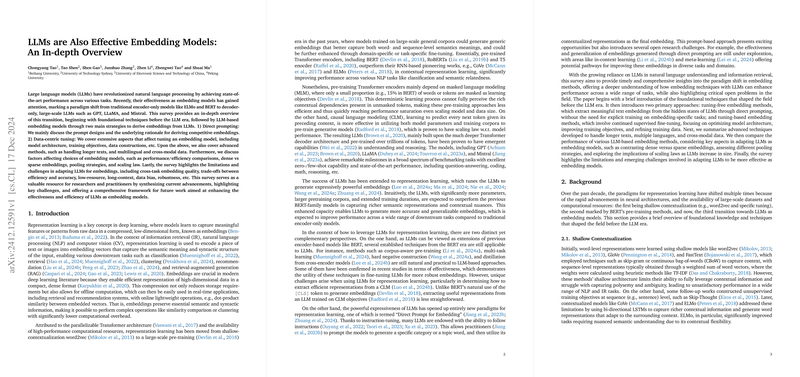An In-Depth Overview of the Paper "LLMs are Also Effective Embedding Models: An In-depth Overview"
The paper "LLMs are Also Effective Embedding Models: An In-depth Overview" explores the shift in embedding methodologies from traditional encoder-based models to utilizing LLMs for embedding tasks. This shift has been facilitated by the remarkable capabilities of models such as GPT, LLaMA, and Mistral, which have demonstrated exceptional performance across diverse natural language processing tasks. This paper provides a comprehensive survey of techniques and advancements in adapting LLMs for generating embeddings, aiming to offer a resource for researchers interested in this domain.
Transition from Encoder Models to LLMs
Traditionally, representation learning in deep learning was dominated by models such as ELMo and BERT, which primarily utilized encoder-only architectures and masked LLMing (MLM) objectives. These models, while effective, were limited by their reliance on partial masking, which restricted their ability to fully internalize contextual dependencies. In contrast, the introduction of autoregressive models like GPT ushered in the era of LLMs that leverage causal LLMing (CLM), offering a more comprehensive contextual understanding.
The paper highlights two primary strategies to derive embeddings from LLMs:
- Direct Prompting: This approach involves designing prompts to elicit embeddings directly from the output of an LLM without additional training. The prompts are crafted to capture semantic nuances and generate high-quality embeddings. The paper of prompt designs and their efficacy constitutes a significant portion of this exploration.
- Data-Centric Tuning: This method refines the embeddings by leveraging extensive training data and optimizing model architecture and training objectives. The paper covers how factors like dataset construction and advanced handling of multilingual and cross-modal data influence embedding quality.
Advanced Techniques and Challenges
The paper explores several challenges and advanced techniques in adapting LLMs to serve as efficient embedding models:
- Handling Longer Texts and Scaling Laws: It details efforts to extend the capability of LLMs to process longer contexts and discusses scaling laws that govern model size and performance enhancements in embedding applications.
- Cross-modal and Multilingual Embeddings: The paper addresses the expansion of embeddings into cross-modal domains and the challenging task of aligning embeddings across multiple languages.
- Performance and Efficiency Trade-offs: A crucial discussion is centered on the balance between the sheer computational power required by LLMs and the efficiency required for real-time applications.
- Adapting LLMs under Low-Resource Conditions: The paper discusses the hurdles in adapting LLMs, particularly in low-resource scenarios where data scarcity impedes effective model fine-tuning.
Evaluation and Comparisons
A significant part of the paper involves evaluating various embedding methods derived from LLMs. Through a range of benchmarks, the efficacy of tuning-free and tuning-based approaches is analyzed. The paper emphasizes that while direct prompting offers effective zero- or few-shot capabilities, fine-tuning often results in higher-quality embeddings, especially in tasks requiring high precision and context-specific understanding.
Implications and Future Work
The findings from this paper have profound implications, both practically and theoretically:
- Practical Implications: LLMs can significantly enhance information retrieval systems, recommendation engines, and other applications that rely on dense and expressive vector representations.
- Theoretical Implications: The exploration aids in understanding the emergent capabilities of LLMs beyond traditional NLP tasks and suggests the potential for developing even more sophisticated models.
- Speculation on Future Developments: Future advancements might focus on making these models more efficient and accessible, addressing their significant computational cost, and extending their application into more specialized domains such as legal, medical, and scientific fields.
In conclusion, this paper serves as a pivotal reference for researchers and practitioners aiming to harness the power of LLMs for embedding tasks, providing a detailed account of methodologies, challenges, and potential avenues for future research.
